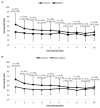Acute Effects of Ballistic and Non-ballistic Bench Press on Plyometric Push-up Performance
- PMID: 30781654
- PMCID: PMC6409677
- DOI: 10.3390/sports7020047
Acute Effects of Ballistic and Non-ballistic Bench Press on Plyometric Push-up Performance
Abstract
The purpose of this study was to examine the effects of a ballistic or non-ballistic concentric-only bench press (COBP) on subsequent plyometric push-up performance. Fourteen resistance trained men completed two separate one-repetition-maximum (1RM) testing sessions followed by three randomized experimental explosive push-up sessions. These sessions combined a heavy concentric bench press with plyometric push-ups. Using a series of 3 × 10 (condition × time) repeated measures ANOVA, comparisons were made between the effects of ballistic and non-ballistic bench presses on performance of plyometric push-ups to investigate push-up performance variables. Compared with the control condition, both ballistic and non-ballistic bench presses produced lower net impulse and take-off velocity data. No differences were found between ballistic and non-ballistic conditions comparing net impulse and take-off velocity. We conclude that the magnitude of loading used in the current investigation may have caused acute fatigue which led to lower push-up performance characteristics. This information can be used to alter loading protocols when designing complexes for the upper body, combining the bench press and plyometric push-ups.
Keywords: ballistic; bench press; post-activation potentiation; push-up.
Conflict of interest statement
The authors declare no conflict of interest.
Figures



Similar articles
-
Evaluating Upper-Body Strength and Power From a Single Test: The Ballistic Push-up.J Strength Cond Res. 2017 May;31(5):1338-1345. doi: 10.1519/JSC.0000000000001832. J Strength Cond Res. 2017. PMID: 28166187
-
The Effects of Plyometric Conditioning on Post-Activation Bench Press Performance.J Hum Kinet. 2020 Aug 31;74:99-108. doi: 10.2478/hukin-2020-0017. eCollection 2020 Aug. J Hum Kinet. 2020. PMID: 33312279 Free PMC article.
-
Acute explosive-force movements enhance bench-press performance in athletic men.Int J Sports Physiol Perform. 2006 Sep;1(3):261-9. doi: 10.1123/ijspp.1.3.261. Int J Sports Physiol Perform. 2006. PMID: 19116439 Clinical Trial.
-
Post-activation Performance Enhancement in the Bench Press Throw: A Systematic Review and Meta-Analysis.Front Physiol. 2021 Jan 15;11:598628. doi: 10.3389/fphys.2020.598628. eCollection 2020. Front Physiol. 2021. PMID: 33519506 Free PMC article.
-
A brief review of strength and ballistic assessment methodologies in sport.Sports Med. 2014 May;44(5):603-23. doi: 10.1007/s40279-014-0145-2. Sports Med. 2014. PMID: 24497158 Review.
Cited by
-
Upper-Body Post-activation Performance Enhancement for Athletic Performance: A Systematic Review with Meta-analysis and Recommendations for Future Research.Sports Med. 2022 Apr;52(4):847-871. doi: 10.1007/s40279-021-01598-4. Epub 2021 Nov 26. Sports Med. 2022. PMID: 34826109 Free PMC article.
-
Antagonist activation exercises elicit similar post-activation performance enhancement as agonist activities on throwing performance.BMC Sports Sci Med Rehabil. 2023 Mar 27;15(1):44. doi: 10.1186/s13102-023-00657-9. BMC Sports Sci Med Rehabil. 2023. PMID: 36973790 Free PMC article.
-
The effects of velocity-based versus percentage-based resistance training on athletic performances in sport-collegiate female basketball players.Front Physiol. 2023 Jan 10;13:992655. doi: 10.3389/fphys.2022.992655. eCollection 2022. Front Physiol. 2023. PMID: 36703922 Free PMC article.
-
Bench Press Range-of-Motion and Velocity-based Repetition Control: Effects on Ballistic Push-up Performance in Males.Int J Exerc Sci. 2024 Jan 1;17(1):38-53. doi: 10.70252/USAK1758. eCollection 2024. Int J Exerc Sci. 2024. PMID: 38665164 Free PMC article.
-
Does one heavy load back squat set lead to postactivation performance enhancement of three-point explosion and sprint in third division American football players?BMC Sports Sci Med Rehabil. 2021 Jun 7;13(1):64. doi: 10.1186/s13102-021-00288-y. BMC Sports Sci Med Rehabil. 2021. PMID: 34099030 Free PMC article.
References
-
- Newton R. Developing maximal neu romuscular power: Part 2—Training considerations for improving maximal power production. Sports Med. 2011;41:125–146. - PubMed
LinkOut - more resources
Full Text Sources
Medical

